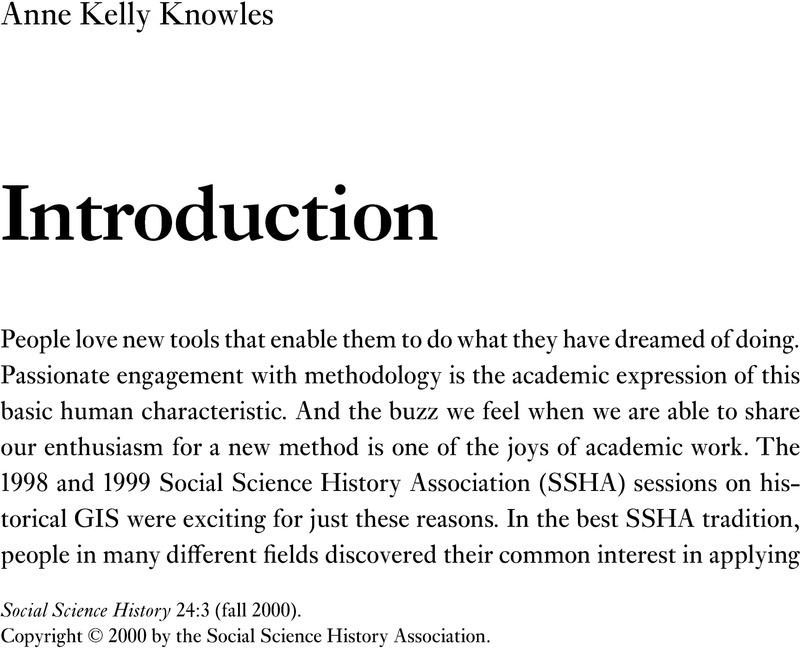Crossref Citations
This article has been cited by the following publications. This list is generated based on data provided by
Crossref.
Orford, Scott
Dorling, Danny
Mitchell, Richard
Shaw, Mary
and
Smith, George Davey
2002.
Life and death of the people of London: a historical GIS of Charles Booth's inquiry.
Health & Place,
Vol. 8,
Issue. 1,
p.
25.
Arai, Yoshio
and
Koike, Shiro
2003.
Modelling Geographical Systems.
Vol. 70,
Issue. ,
p.
235.
Gregory, Ian N.
2008.
Different Places, Different Stories: Infant Mortality Decline in England and Wales, 1851–1911.
Annals of the Association of American Geographers,
Vol. 98,
Issue. 4,
p.
773.
Janelle, Donald G.
Rebich Hespanha, Stacy
Goodchild, Fiona
and
Goodchild, Michael F.
2009.
Workshops and National Dissemination of Geographic Analysis in the Social Sciences: the CSISS Experience in the USA.
Journal of Geography in Higher Education,
Vol. 33,
Issue. sup1,
p.
S88.
Cioffi-Revilla, Claudio
2010.
Computational Social Science.
SSRN Electronic Journal,
Pinol, Jean-Luc
2010.
Les atouts des systèmes d'information géographique – (SIG) pour « faire de l'histoire » (urbaine).
Histoire urbaine,
Vol. n° 26,
Issue. 3,
p.
139.
Logan, John R.
Jindrich, Jason
Shin, Hyoungjin
and
Zhang, Weiwei
2011.
Mapping America in 1880: The Urban Transition Historical GIS Project.
Historical Methods: A Journal of Quantitative and Interdisciplinary History,
Vol. 44,
Issue. 1,
p.
49.
Rose-Redwood, Reuben
and
Li, Li
2011.
From Island of Hills to Cartesian Flatland? Using GIS to Assess Topographical Change in New York City, 1819–1999.
The Professional Geographer,
Vol. 63,
Issue. 3,
p.
392.
Lesger, Clé
and
Van Leeuwen, Marco H. D.
2011.
Residential Segregation from the Sixteenth to the Nineteenth Century: Evidence from the Netherlands.
The Journal of Interdisciplinary History,
Vol. 42,
Issue. 3,
p.
333.
Karakuyu, Mehmet
2011.
A New Approach to Analyzing Historical Urban Growth of Ottoman Cities: Manisa Case Study.
Historical Methods: A Journal of Quantitative and Interdisciplinary History,
Vol. 44,
Issue. 3,
p.
131.
Bol, Peter K.
2013.
On the Cyberinfrastructure for GIS-Enabled Historiography.
Annals of the Association of American Geographers,
Vol. 103,
Issue. 5,
p.
1087.
Baker, Alexi
2013.
History and GIS.
p.
89.
Knowles, Anne
2014.
The contested nature of historical GIS.
International Journal of Geographical Information Science,
Vol. 28,
Issue. 1,
p.
206.
Ferrighi, Alessandra
2015.
Handbook of Research on Emerging Digital Tools for Architectural Surveying, Modeling, and Representation.
p.
425.
Carneiro, Patrício Aureliano Silva
2018.
Questões teóricas e metodológicas da Geografia Histórica.
Terra Brasilis,
Рыгалова, Мария Владимировна
2019.
Применение исторических ГИС в исследовании социальных и экономических процессов.
Izvestiya of Altai State University,
p.
77.
Trepal, Dan
Lafreniere, Don
and
Gilliland, Jason
2020.
Historical Spatial-Data Infrastructures for Archaeology: Towards a Spatiotemporal Big-Data Approach to Studying the Postindustrial City.
Historical Archaeology,
Vol. 54,
Issue. 2,
p.
424.
Bryukhanova, Elena
Krupochkin, Evgeniy
and
Rygalova, Mariya
2020.
The reconstruction of the Siberian cities historical topography by means of GIS technologies (the case of Tobolsk at the turn of the 19th–20th c.).
InterCarto. InterGIS,
Vol. 26,
Issue. 4,
p.
202.
Brando, Carmen
Frontini, Francesca
Moreau, Dominic
Roche, Mathieu
and
Masson, Éric
2021.
Introduction. Humanités numériques et analyses spatiales : enjeux et perspectives.
Humanités numériques,
Arkhipova, Olga
Semenova, Olga
Afanasenko, Vladimir
and
Podoyan, Elena
2021.
Monitoring of historical and cultural heritage objects based on modern information technologies.
InterCarto. InterGIS,
Vol. 27,
Issue. 4,
p.
434.
